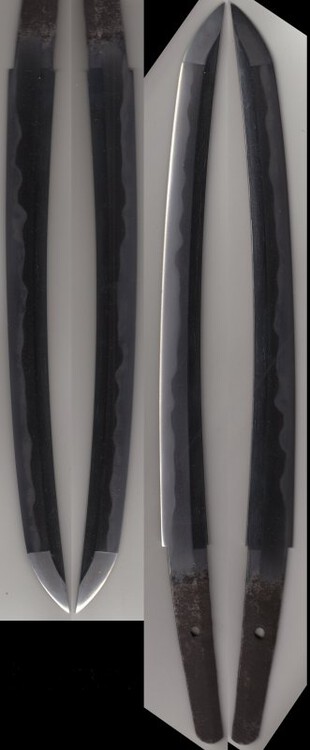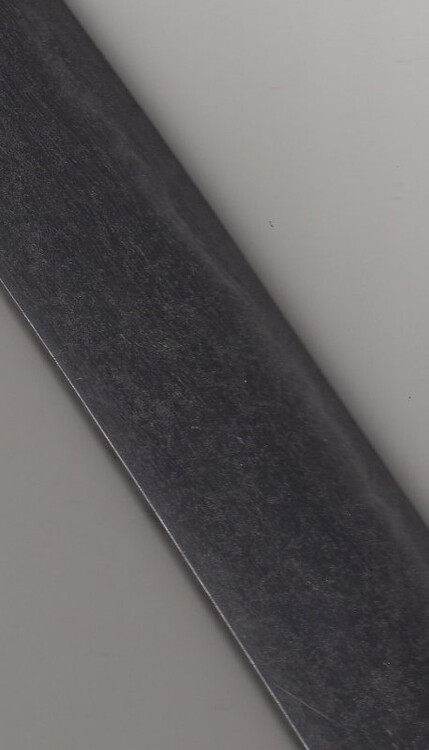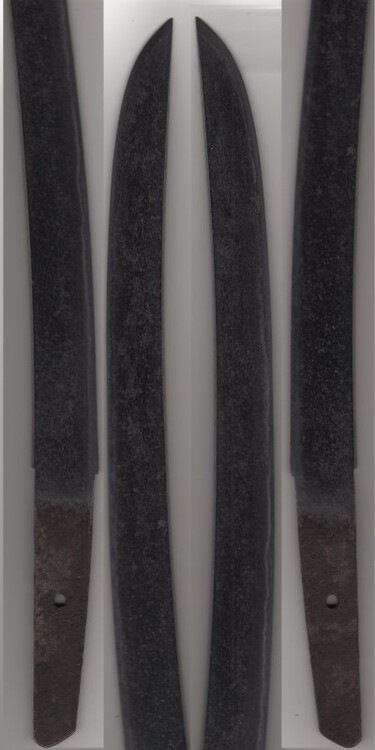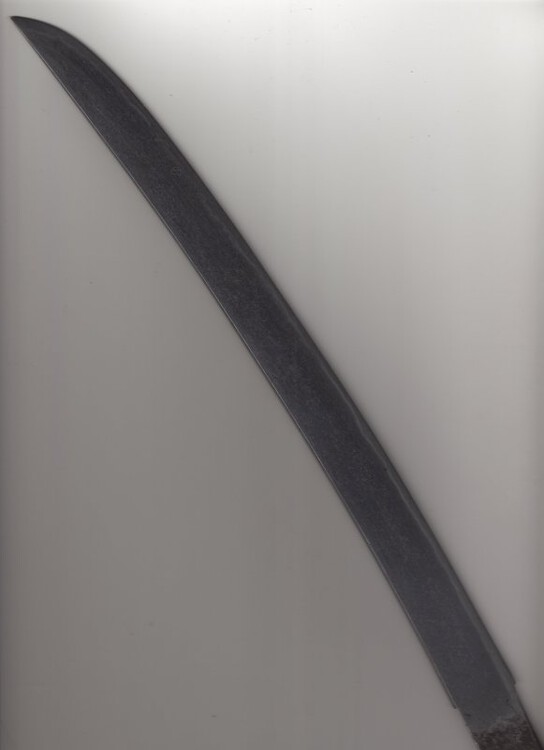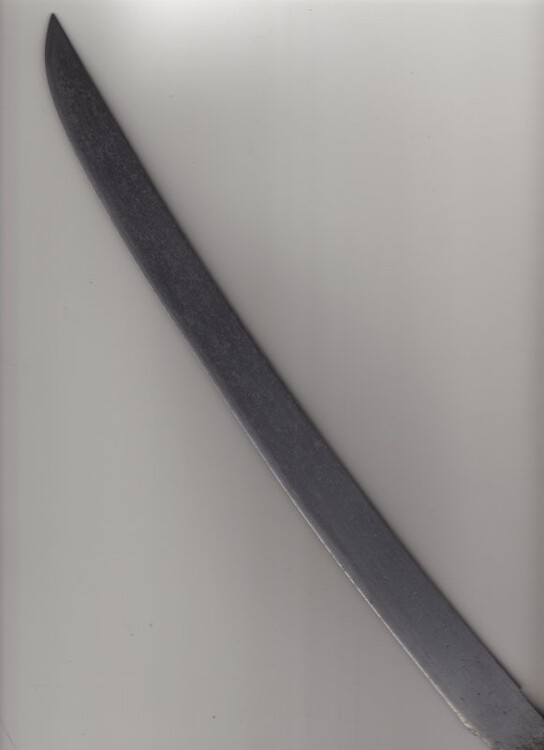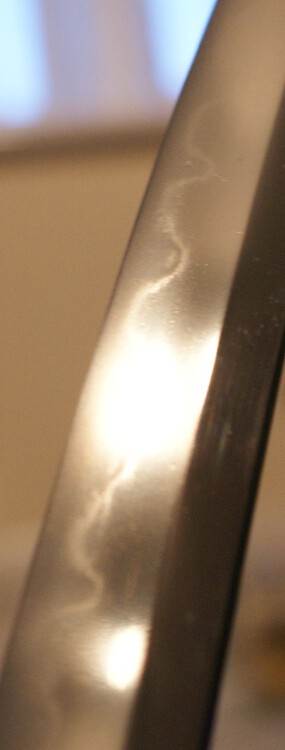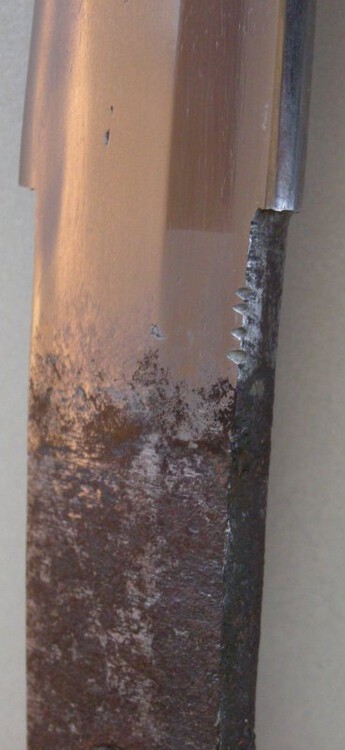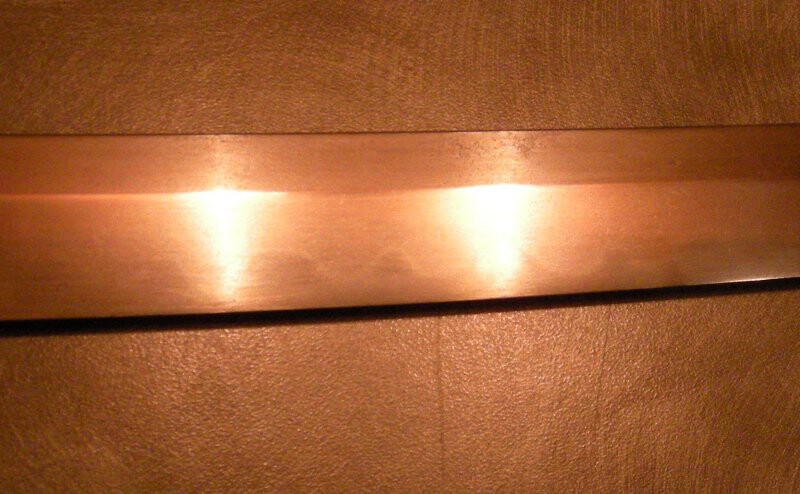
shan
Members-
Posts
330 -
Joined
-
Last visited
Content Type
Profiles
Forums
Events
Store
Downloads
Gallery
Everything posted by shan
-
I have this Tsuba that i had not researched and one day last week i was browsing the net and saw a very similar one attributed to Akasaka sukashi Tadatoki 4th Generation. Not knowing anything about this area of sword fittings, i also asked a few people by email what they thought of it and it came back as. its a mantis and wheel theme that akasaka were known for in an abstract form.Most thought it without doubt Akasaka and many thought one of the middle Tadatoki smiths. "Their workmanship shows a combination of Kyo-sukashi and Owari-sukashi first then adds a taste of the Hayashi school of Higo tsuba later.Their tsuba is relatively thick and then has round mimi (outer line) and a little large hitsu-ana also powerful ke-bori carving is done on it." Some liked the item although one thought it rather "roughly made" and another thought it possibly a middle tadatoki work but when he was studying (not yet a master). Some loved it.Felt it would paper to Akasaka no problem and it was a good Tsuba and later tadatoki 5th or 6th gen. and recently one thought it modern Junk. All opinions were "Not in hand" so i cannot quote anyone without permission. I would love your opinions on this "good or bad" as the "jury is still out" on whether this is Nice or complete Junk. I had some interest in it from several people, but wanted to "hold off "until i could be sure it was what i was selling it as. The Photo colours are not consistent sorry,I have also gently cleaned some wax and stuff from it since these images were taken. Many thanks Shan
-
The type was the small Kiso horse, named after the area through which the Kiso River runs, from Nagano prefecture through Gifu and into Ise Bay west of Nagoya city in Aichi prefecture. While the small Kiso horse is indigenous to the Japanese archipelago, larger horses used for riding and warfare were imported from Korea. Korean horses were introduced around the middle of the Kofun period, and were never very large. It would seem that the earlier Kiso horse decreased in number before the introduction of the continental/peninsular horses.It may be that this is a "celebration" of the indiginous Japanese horse that we westerners would call a "Pony". I have seen many depictions of horses and all appear to be "Ponies" as opposed to true "horses" but due to stature limitations one persons "pony" may be another persons "Horse".
-
Hi, I don`t see that Tsuka as a write off at all. The same is fine and just needs to have the paper wedges removed and a light cleaning before being rewrapped. I do agree that the Fuchi Kashira is somewhat plain but then that was the desire of the owner i would guess,to allow the emphasis on subtlety and concentration on the fittings less and blade more..Perhaps Understatement? I think that if a tsuka is servicable and of any age,we should attempt to restore it and not just opt for complete replacement all the time. After all whats the point in haveing a Koto blade in modern mounts? Westerners have a habit of wanting fittings all matching and fancy looking and this is not always the best option and in Japanese terms may just be showing off Perhaps?. Anyway i like the mounts so if you opt for complete replacement give me a shout and i will have them off you.Tsuba,Kogai,Kozuka and Boar menuki included of course Nice set by the way,I would keep it all intact and foot the bill for repaires to the Saya with family Mon. Just my unwanted 50 cents worth regards Shan
-
Weird swords on ebay.... Seller ok?
shan replied to kusunokimasahige's topic in Auctions and Online Sales or Sellers
Is it possible that some of those badly corroded blades are in fact Grave goods? They loo like they have been in the ground for decades (or a bog or Marsh) shan -
I Know you have all seen this one before and most don`t like it much, but it is my favourite for now (until the 3 come back from the togoshi). Its a lovely wakizashi to me and has a lot of hataraki. I will one day get around to offering it up for shinsa. My guess is its a late Koto blade. For all those who have not seen it before it is 25cm long and came in full wakizashi miniature mounts. I love it for its size
-
Gunto Sword on ebay... interesting? or a do not bid one?
shan replied to kusunokimasahige's topic in Military Swords of Japan
Looks in the style of Kanemoto to me.Sanbonsugi with Toran mixed in This is a hamon that was popular in Gunto periods as well as earlier and i would have liked to see the nakago myself. I understand that some swords are difficult to prize from the tsuka but there is an age old technique that is mentioned in a lot of sword books about holding the sword in the right hand point up by the Tsuka and sharply striking the top of the right hand with the bottom of the left hand. This if done smartly will "shock" the nakago free. It will not cause any significant damage because any surface rust will be loose and all the better for that,also whoever buys that blade will want to see the nakago regardless of what may or may not happen to it in the attempts to remove it. It’s a fact of life I am afraid,no one will leave that in the Tsuka,Its human nature to want to know if its Koto,Shinto or gunto,signed or not signed. So the question is….whats under that Tsuka? -
Hi Jean, Here you go. If you want to tell me the area your interested in (i.e Yasureme or Hamon) i may be able to concentrate on that area.
-
Hi Sabastian, A description for you. Its a shallow Iori Mune and 33.4cm long nagasa Wakizashi/Sunnobi Tanto. Hada is a pure masame being very pronounced and distinct & that follows the hamon line making the turn at the yokote into the kissaki in a line along the curve and it runs out into the mune.Blade has tate-wari. Hamon i thought was either a Ko Midare based on suguba or a suguba Hotsure ending with yakisume at the boshi and in nie-deki. There appears uchinoke along the edge of the hamon as well as nijuba and kuchigai.The nie line is wide and there is coarse nie mixed in. Rest is indistinct. The Nakago is Ha agari Kuri Jiri & yasurime are Kesho one side and Katte Agari/Higaki the other. Mekugi ana is Punched not drilled. Its this strange finish to the nakago that made me think it was O suriage.There is no real form to the Yasureme. I hope this helps. Any opinions on this would be very much appreciated. shan
-
I have some better images of this bladedo wanted to update this thread,rather than start a new one. Sill looking for some sort of Kantei on this blade really. I had this reply from one person "I had a look at your tanto and mounting. I had an impression that the tanto (it keeps the original shape) was made by a smith related to the Hosho school of Yamato Province in the late 16th Century but not belongs to the main school." What are your thoughts anyone? I can supply very large images if you give an email address by PM. thanks shan
-
Hi Louis, That one with shinogiji is certainly well crafted from what i can see. I look forward to seeing it when polished. shan
-
Poll:- New collectors and ages of Nihonto enthusiasts
shan replied to Brian's topic in General Nihonto Related Discussion
I am 45 now and found my first sword hanging in a barn i was working on in Devon in 1988. It leapt out from the rest of the junk cluttering the place. It was In a darkest Red/black saya with a plain Mokku gata Tsuba (signed Kunihiro) and copper habaki and seppa,The menuki were flowers and F/K were of samurai riding horses and the kashira there arms (Armour,Helmet,bow, Lance, tanto, katana,Wakizashi etc).(if i remember correctly i was told it was the 7 items of the samurai)? The blade had not been cleaned for many years and sawdust had settled on the Koshirae over the years from the Bench saw.(It still stood out from everything else to me though,Like a flashing beacon) I could just make out the Hamon through the years of grime. I asked if it was for sale and the owner said "sure,why not,how about £50?" I paid the money and walked the 1 mile country lane home with a large smile on my face carrying the sword reverently and carefully in both hands. Later research found the blade to have no Kizu and was almost completely flawless and tempered in Sudare Ba. After discovering how to remove the Tsuka i found the Japanese mei for Tamba no Kami Yoshi Michi.(Victor Harris Of the BM had a look and told me it was from the Mishina school of Smiths if i remember correctly) I sold the sword a year later to a collector for a tidy profit .(It was an offer i could not refuse in my defence,but i always regreted selling it) I never forgot how much i enjoyed owning a sword. I did not collect again until last year when i decided to enter the Nihonto world again after seeing a WWII sword in a junk shop. I seem to enjoy collecting at a fairly low level and like to keep purchases below £2000. This way i get no complaints from my wife. Of Nihonto or Tosogu,I have nothing of any considerable Value but i am inspired by everything i own in some way or another and want to know as much as i can about them. regards Shan -
Sorry again Jacques,i should have posted an image. the higaki question "2. Can we determine a school based on a Nakago with Higaki Yasureme?Satsuma Naminohira was one that used this i believe, but what others did in the shinshinto period specifically?" This was directed as a general question but about a specific sword i have. Thanks shan
-
Hi John, To be honest i had no thoughts on it at all,but i do remember seeing one very similar to it once so saved the files. NB My Blade:It has an Itame Hada. I am, as ever, an optimist ,but ......let me just "jump out of the frying pan and into the fire" .... i see marked similarities to this blade by Nihon Kaji Sosho Iga no Kami Kinmichi. and even more so after a few beers :D Superficial similarities agreed but the modern study of Nihonto is superficial to a degree.....Anyway the Yasureme,hada and hamon are very similar,The nakago as well but the Kinmichi is Suriage. The blade in my question shows little or no Yakidashi though. Maybe Den Kinmichi i though or an earlier gen? I have a slightly shorter but thicker,stouter Blade with the same nakago as this one and a Midare/Gunome/notare hamon. The nakago on both is almost identical in age and looks. Are we leaning towards Mino thanks Shan
-
Hi Mark, the best i can do at short notice and on an out of polish blade. Feel free to have a go at Kantei though. If you need better let me know but its not easy on a blade thats this far out of polish. thanks shan
-
"BTW, I am not a specialist of kogatana, like tsuba, I buy sometimes a piece I like." Me Neither, But i know what i like and these are worth some consideration. I understand that most are Gimei.....so about the same odds as swords... that some will be shoshin then i guess. If i were to state my favourite part of a koshirae it would be the Menuki,I love the miniature characters and symbols. second would be the Kogatana and Kozuka. Whilst i can appreciate the rest...it does not inspire me so much. shan
-
I this hamon indicative of a school and period? I think the blade is approx 1600`s or early based on Nakago comparisons. Feel free to brainstorm people. shan
-
Hi I have a blade by a smith named Kinkanzan Kiyonaga. I am reliably informed that this smith produced swords as well as Kogatana and placed as much reverence on the small blades as he did the larger ones.There was an almost identical one for sale through Aoi Art a short while ago and its mei was almost identical to mine. I have shown it for comparison. I guess some where well made and others were not,some where gimei and some Shoshin? regards shan
-
Very Nice items Jean. I can see the appeal of these little Gems. Do you intend to sell these or are you just doing a "show and tell"? :lol:
-
Hi Nick, Does not look like any truly great quality and about the same as anything i have offered up and had shot down in flames. Perhaps quality is in the eye... so to speak. I like it though and i like the theme and have a F/K that would work well with this. Let me know if you decide to sell it on complete as i have a few Kogatana booked with a togoshi and i could squeeze this one in as well. Let that be a general request for any signed Kogatana blades that are traditionally forged and tempered. I am thinking of moving into a different direction and these do take a lot less space up. regards Shan
-
what does the description sugest?
shan replied to shan's topic in General Nihonto Related Discussion
Hi all I can see that this blade has elicited some differing responses and opinions. The Mekugi ana are exactly the same size as almost all of my blades and appear approx the "standard" size for a Mekugi ana. The hamon is very precise I agree but I believe still genuine and shows No Mizukage. The nakago shows signs of at least one previous machiokuri above the first Ana and I believe the blade to be O-suriage. I agree that the hi is not of a particular skilled finish and the nakago was a hasty job but we do not know the reasons why this is the case or when it was done and do not know that this was not a broken blade of some importance once or even a Satsuma rebellion reworking. The blade is very slender and as stated has a 25mm motohaba.(polished many many times i would guess) I also understand that the addition of this Hi was sometimes to rebalance a blade that had lost its balance because of suriage or to cover Flaws in the steel. The Blade came with a Black saya of fairly good quality with Kozuka and Kogai slots and a Silver Fuchi, 2 silver foil seppa, Silver double Habaki (Custom fitted to take into account the Hi shape) and a solid silver Tsuba.Everything fits very neatly to the nakago and Blade. I believe someone thought this a family blade worthy of preservation and this is the reason for its continued existence and its reasonably valuable Edo period mounts. The Tsuka was unwrapped with no menuki but had an Ebony Kashira added much later that matched the saya. This may also be a tourist piece of course but I would put money on the blade being genuine and at the very latest Shinto. I would love to know what is ringing these alarm bells for most of you. -
Here is a quick image of one that is shinto and has the notches.They got a bit cleaned in the polish but are there non the less. The blade has a punched and irregular Mekugi Ana. I will hunt out some of the others. Shan
-
Sorry ,this is my fault for not showing an image. Its not sanbonsugi as i would recognise it Stephen i would know that one as i would all the other known basic styles. Its not listed in any book and i cannot find it on the internet. Its a large gentle hill and then a pointed mountain repeated over and over. So a Gunome with Mt Fuji ? The blades well out of Polish so i am having trouble capturing it but try this:
-
This has probably been covered already but just so i know: 1. What do we call the hamon that appears shaped as a gentle hill then a pointed mountain,then gentle hill then pointed mountain and so on? 2. Can we determine a school based on a Nakago with Higaki Yasureme?Satsuma Naminohira was one that used this i believe, but what others did in the shinshinto period specifically? If i had a list i could then try to whittle down a bit. hopefully Shan
-
what does the description sugest?
shan replied to shan's topic in General Nihonto Related Discussion
all fair statements and further enhance what i already half believed. I am 99.9% sure it is a genuine Blade,but it may well be of little importance and as i have many to polish i will place this one on the "backburner" for a while. My thanks for your input Gentlemen. Very much appreciated. shan -
Hi Ken, I alway thought that Heianjo was inlay not overlay but i am definatly going to be corrected on this. I have to admit i like it though. shan






